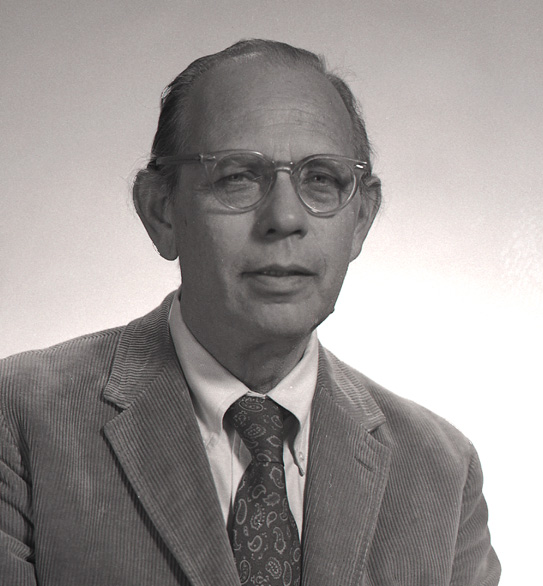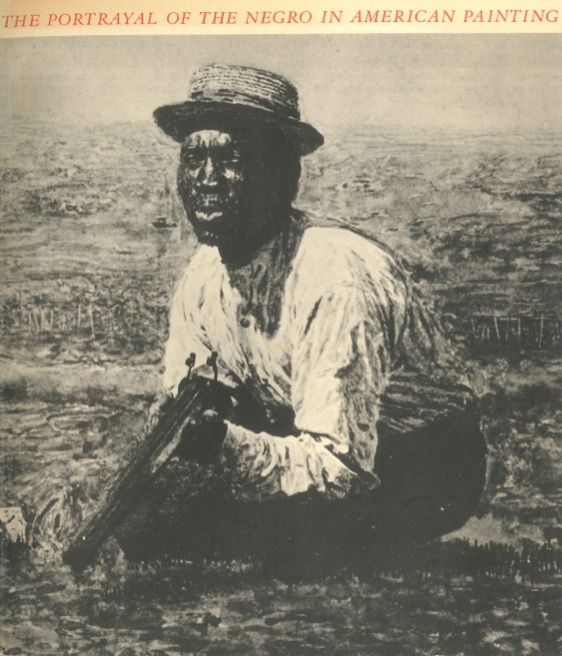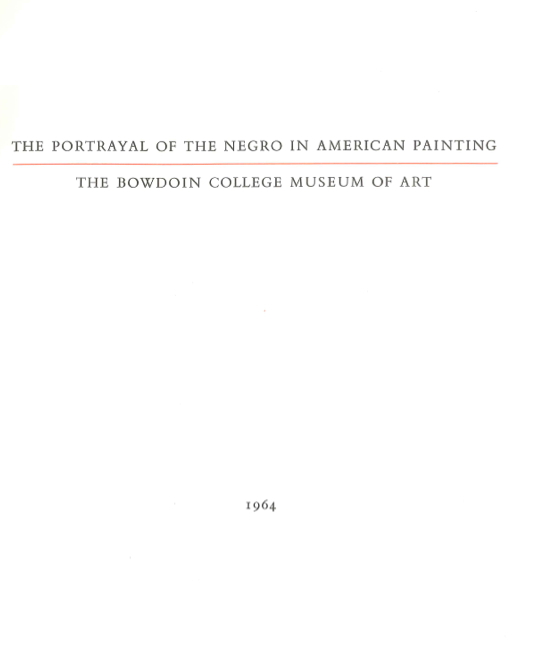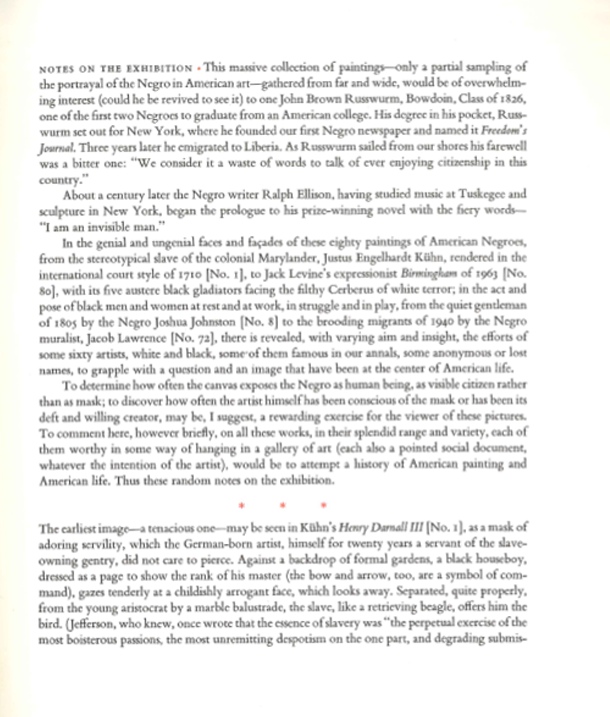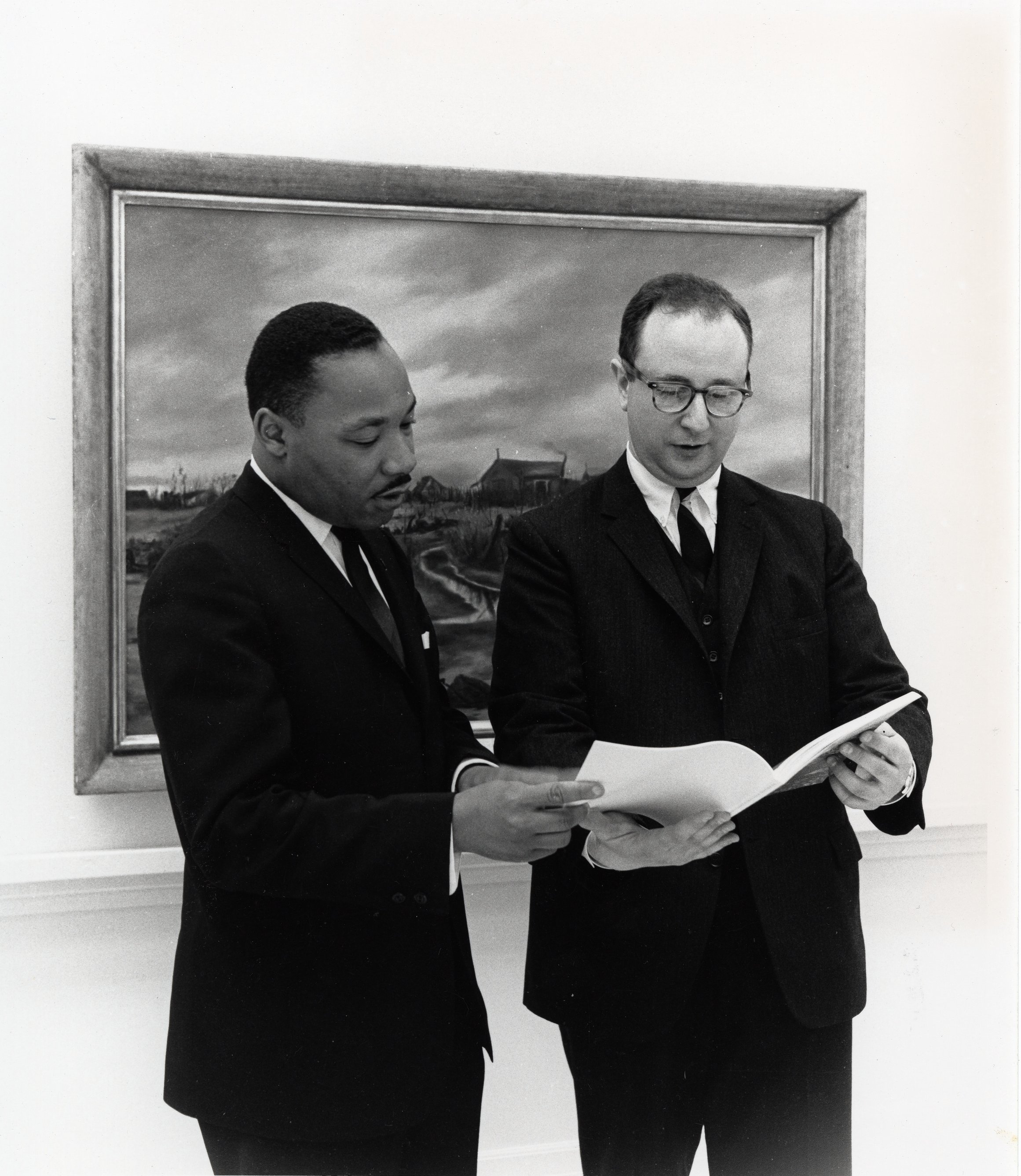CLICK ARROW TO REVEAL ESSAY
Fifty Years Later: An Introduction
The Portrayal of the Negro in American Painting was a landmark exhibition organized by and exhibited at the Bowdoin College Museum of Art during the summer of 1964. This digital initiative examines the exhibition’s compelling yet under-recognized content and legacy. The original show included eighty paintings from over fifty prestigious museums and private collections across the United States. Featuring major works by artists such as Henry Ossawa Tanner, Thomas Eakins, Winslow Homer, and Horace Pippin, it was one of the first surveys of great American paintings that represented African-American subjects. Critically acclaimed at the time, the exhibition drew over 19,000 visitors (well beyond the number of people who usually visited the museum in an entire year). It attracted high-profile national attention, including visits and praise from Reverend Dr. Martin Luther King, Jr. and New York Governor Nelson A. Rockefeller. Organized at the height of the civil rights movement, The Portrayal of the Negro in American Painting was recognized at the time for bringing together art and sociology, showing an evolution of the portrayal and roles of African Americans in American society from the colonial period to the present.
Bowdoin College may have seemed like an unlikely venue for such an exhibition. The student body of the rural Maine college was then all-male and predominately white, and the campus was physically distant from the nexus of the civil rights movement. However, certain Bowdoin students and faculty were committed to prompting discussions of racial inequity, and were instrumental in bringing key players to campus, including Dr. King. Furthermore, the Bowdoin College Museum of Art was not known for staging major loan exhibitions before this time. The Portrayal of the Negro in American Painting was initiated by the ambitious young curator Marvin S. Sadik, who had joined the Museum in 1961. He forwarded a progressive perspective that assessed the significance of artworks by their level of political engagement. In Sadik’s view, caricature and stereotyped portrayals found in illustrations and photographs of African-Americans did not qualify as art of quality, and thus were not part of the exhibition. Sadik only included paintings that he felt conveyed a positive pictorial record of the “American Negro” that had “enriched the life and art of the nation.” [1] Re-examining this exhibition fifty years later allows us to recognize its achievements, but also to question this curatorial approach. Because this show excluded negative portrayals of African-American subjects, what aspects of discrimination and stereotyping of African Americans in visual culture were entirely avoided? How did these elisions then shape the discourse of the exhibition’s reception in the media? By prioritizing painting, how did the exhibition neglect aspects of the lives of African Americans that were only represented in photographs or other mediums?
Bowdoin students enrolled in the Spring 2014 art history undergraduate seminar, Race and Representation in Visual Art, 1620-1976, confronted these and other themes and questions. They were charged with developing a research topic addressing some aspect of the show and its afterlife. This website features concise versions of their longer seminar papers. Each student also completed provenance research on the eighty paintings exhibited in 1964.
As can be read below, approaches to the exhibition and historic materials vary. Alexandra N’Diaye and Anna Prohl transformed the provenance information into the seeds of an essay that considers the circulation of paintings of African Americans in the United States as a means of better understanding the show’s checklist. Amanda Montenegro and Taylor Guiffre provide a visual analysis of two paintings: Joshua Johnson’s Portrait of a Cleric, and Francis Coates Jones’s The Orchard. Both of these paintings were exhibited in the 1964 show and are in the permanent collection of the Bowdoin College Museum of Art. Shannon Brady and Auburn S. Gonzales assess student life at Bowdoin during the turbulent civil rights era, including Reverend Dr. Martin Luther’s King’s seminal visit to Maine. Jessica Holley plumbs the exhibition records at the Bowdoin College Library’s George J. Mitchell Archives & Special Collections and uncovers troves of documentation of the exhibition. Emily Stewart provides an essay about Marvin Sadik’s curatorial vision for The Portrayal of the Negro in American Painting. James Denison offers a concise history of related exhibitions of African-American subjects. Gretchen Williams and Elisabeth Strayer present intellectual biographies of the curator Marvin Sadik and Sidney Kaplan, the essayist of the exhibition catalogue. Alex Pigott examines the design of the exhibition catalogue by artist Leonard Baskin. Presented together, their contributions offer multiple distinctive frameworks for addressing the content of the exhibition and the complex political, social, and cultural issues that surrounded it.
It is our hope that the research conducted by a new generation of scholars will generate renewed interest in this landmark exhibition. Fifty Years Later brings a twenty-first century perspective to the show, demonstrating the perpetual significance of art and art history as catalysts for urgent social and political dialogues. By exploring issues of race and representation from the past, we may be able to more critically understand these potent topics today and in the future.
ENDNOTES
[1] “The Negro in American Painting,” Bowdoin Alumnus, May 1964 (Bowdoin College: Brunswick, Maine), 10.
Steps toward Recognition through Openness and the Virtual
Academics, activists, and business leaders alike call out for cross-disciplinary ventures that address issues of social justice. The digital “open” movement responds by striving “to give access to diverse modes of knowing and becoming rather than a technical label for a publishing or property model.”[1] The complex labor of real collaboration and getting these projects off the ground and out to the public remains less addressed. In this brief essay, I reflect on the work of producing the open and collaborative website, Fifty Years Later: The Portrayal of the Negro in American Painting, and the importance of such digital initiatives when examining issues of social injustice.
The original show, though momentous, has not been recognized in previous scholarship about the history of exhibitions of African-American subjects and artists [2]. The Fifty Years Later website allows the user to experience each of the original artworks in the exhibition in a digital format alongside contemporary reflections about select pieces, the historical period, the context of the museum, and the climate of Bowdoin’s campus amid the civil rights movement. By featuring a digital gallery of reproductions of the works in the show alongside contemporary writing by a new generation of scholars that address broader cultural and historical contexts, this website makes issues of justice and injustice more visible. One of the questions I find myself asking is whether the original exhibition brought about changes in public perception regarding the representation of African Americans in American society? Despite this unresolved issue, this web project surely reveals an obscured past of this exhibition and adds to the necessary work of bringing greater visibility to the under-recognized life, work, and experience of African-Americans.
Our design team—including myself, Cody Stack ’16, Sarah Montross, Andrew W. Mellon Post-doctoral Curatorial Fellow, and Dana E. Byrd, Assistant Professor of Art History—sought to create an useful, exciting, and clean information architecture for this website. Through iterations of information architecture design, web platform choice, and even assignment creation and review, I worked as the translator to bridge these realms. As both a scholar of social and spatial justice and an expert in digital studies, my role inspired many questions for me: What are the limits and affordances of technology for a virtual exhibit? What is the best platform to make this user-friendly not only to the public and scholars? While the site makes the 1964 exhibition more public, how can such openness further our recognition of and actions on issues of race and racism today?
I addressed such questions with a team of experienced scholars and coders over almost a year. We found how exciting and also limiting the possibilities with the new format of a virtual exhibition and addressing such important material therein. For example, our initial interest to include social network analysis with each artwork—records painstakingly found and organized by students Alexandra N’Diaye ’15, Anna Prohl ’14, and Professor Byrd—was found to be unwarranted when the majority of the art had and continued to reside in major cities in the East and Midwest. Nevertheless the written report summarizing this in-depth research reveals other fascinating patterns that now sit aside a provenance map created by Gina Stalica ’16 and myself [3]. This website is the first of its kind for the Bowdoin College Museum of Art. More sites like this will follow and grow across the art world. This will allow for more probing questions to be raised while heightening user experience and extending academic scholarship. As the merit and production of virtual exhibitions grows, it is important to reflect on what exactly we seek to open to the public, the matter in which we do it, and what such openness provides in terms of visibility, recognition, and/or action. The ability to create any steps toward a more just future can never be overlooked.
ENDNOTES
[1] Donovan, Gregory T., and Suzanne Tamang. 2014. “Introduction: Media and Methods for Opening Education.” Journal of Interactive Technology and Pedagogy, no. 5. http://jitp.commons.gc.cuny.edu/introduction-media-and-methods-for-opening-education/.
[2] See James Denison, Related Exhibitions: 1940—1970s on this webpage
[3] See Dana E. Byrd, Peripatetic Paintings: Provenance and The Negro in American Painting on this webpage
The Portrayal of the Negro in American Painting: An Overview
The Bowdoin College Museum of Art’s well-attended exhibition, The Portrayal of the Negro in American Painting was pioneering both in scope and subject. Marvin Sadik, the museum’s curator, had a distinct vision for the exhibition, which reflected his views about the function of art museums, as well as the correspondence between the historic role of African-Americans in society and their contemporaneous representation in art. Sadik transformed the Bowdoin College Museum of Art from a relatively staid college art museum into a nationally-recognized forum by organizing a survey of great American paintings with largely positive portrayals of African-American subjects. For Sadik, the best art had a strong aesthetic impact but was also capable of awakening the political spirit in its viewers. Upon viewing this exhibition, viewers were meant to understand an enduring presence of African Americans in American history.
Sadik organized the show in chronological order to create a cohesive visual narrative. The show began with Justus Englehart Kühn’s Portrait of Henry Darnall III (1710), which was, at the time, one of the first known representations of an African-American slave in American painting. The painting portrayed the black servant as the trope of an “interesting exotic” in the eighteenth century. By the mid-nineteenth century, representations of blacks appear in genre paintings as music-loving ruffians whom whites regarded with affection. After the Civil War, the dominant visual type was the African American as a “happy, honest, religious, devoted family man who did not question his depressed position.” [1] This narrative is largely one of racial harmony, white benevolence, and black submissiveness, which average viewers might have believed without the aid of historical context.
Contemporary paintings included Jacob Lawrence’s And the Migrants Kept Coming (1940-41) and Ben Shahn’s The Church is the Union Hall (1946). The exhibition concluded with Jack Levine’s Birmingham (1963), a social realist painting commenting on racial injustice. These images suggest emerging African-American social independence and reactions against oppression. They create a narrative of social progress that was well suited to the show’s political context during the civil rights movement. Sadik explicitly stated in his catalogue text that The Portrayal of the Negro in American Painting was a “significant social document dealing with one of the decisive issues of our time.” [2] Despite the show’s connection to the civil rights movement, Sadik did not use the exhibition to promote an aggressive agenda critiquing the historical portrayal of African Americans in painting. He claimed the paintings selected for the exhibition showed “a singularly revealing pictorial record of the manner in which the American Negro has enriched the life and art of this nation.” [3] Unfortunately, by not directly addressing social inequalities of the representations in the show, he reduced the potential contentiousness of the presence of racist content in this painting. He framed the show as a celebration of great art, and the enduring representation of a minority group in order to inspire reflection and social activism.
ENDNOTES
[1] John Canady, “Negroes in Art: An Exhibition Examines 250 Years of Pictorial Social History,” New York Times, May 24, 1964.
[2] Marvin S. Sadik, Foreword, The Portrayal of Negro in American Painting (Brunswick, ME: Bowdoin College Museum of Art, 1964)
[3] Letter from Marvin S. Sadik to Sidney Kaplan, n.d., Correspondence S” Box 2, Folder 1, The Portrayal of the Negro in American Painting Exhibit Files, 1963-1966, George Mitchell Special Collections & Archives, Hawthorne Longfellow Library, Bowdoin College, Brunswick, ME.
A Portrait of Marvin S. Sadik
The individual primarily responsible for the organization, implementation, and success of The Portrayal of the Negro in American Painting was Marvin S. Sadik, curator of the Bowdoin College Museum of Art from 1961-1964, and director from 1964-1967. With the help of a very small museum staff, he facilitated the loans of nearly eighty paintings, the design of the show, and the creation of a widely praised exhibition catalogue. Sadik also devoted precious time and resources to publicizing the show and catalogue around the country. [2] A politically engaged liberal Democrat[3], he frequently called upon his connections – most notably his friendship with Edmund Muskie (Governor of Maine from 1955-1959 and U.S. Senator from 1959-1980) – in order to help promote the exhibition among political circles in Washington D.C. [4] Looking back on his time at Bowdoin, Sadik was particularly proud of the 1964 show, which provided him the unique opportunity to meet distinguished figures such as Martin Luther King, Jr. An historian and art connoisseur who would infuse his curatorial endeavors with social and political fire, Sadik made a pointed contribution to both Bowdoin’s campus and the nation-wide civil rights movement of the 1960s.
Sadik left Bowdoin in 1967 to become the founding director of the University of Connecticut Art Museum. In 1969, he was offered the position of director of the National Portrait Gallery (NPG) in Washington, D.C. He would devote the next thirteen years of his life to transforming the NPG into a renowned institution. Sadik made a series of major acquisitions for the NPG’s permanent collection, and he spearheaded significant exhibitions such as The Black Presence in the American Revolution in 1973. Remaining socially and politically involved in Washington, Sadik campaigned heavily to have the National Museum of the American Indian built on the Mall. In 1976, he was knighted by the Queen of Denmark for organizing an exhibition on the Danish painter Christian Gullager, and in 1978, he received an Honorary Doctorate in Fine Arts from Bowdoin. [5] In 1981, he retired from his high-paced life in D.C. to return to Maine and devote himself to art collecting and dealing. Sadik passed away on May 29, 2013, leaving the vivid memory of his transformative work and impressionable personality in the minds of the individuals and institutions he touched.
ENDNOTES
[1] Sadik was promoted to Director of the BCMA in 1964 (“New Museum Director,” Bowdoin Alumnus, May 1964, 10)
[2] Records of correspondence, publicity, and news clippings related to “The Portrayal of the Negro in American Painting” can be found in the George J. Mitchell Dept. of Special Collections & Archives, Bowdoin College Library, Brunswick, Maine.
[3] Sadik describes his political affiliations and involvement in an interview with Mike Richard, July 12, 1999, Edmund S. Muskie Oral History Collection, Bates College Digital Library, accessed 05/09/2014, http://digilib.bates.edu/collect/muskieor/index/assoc/HASH0194.dir/doc.pdf.
[4] See correspondence records in “The Portrayal of the Negro in American Painting,” George J. Mitchell Dept. of Special Collections & Archives, Bowdoin College Library, Brunswick, Maine. For more information on the life and work of Edmund Muskie, see “The Edmund Muskie Foundation,” http://www.muskiefoundation.org/index.html.
[5] For further information on Sadik’s incredible contributions to the National Portrait Gallery, see Face to Face, The National Portrait Gallery Blog, August 7, 2013. http://face2face.si.edu/my_weblog/2013/08/marvin-sadik-19322013.html.
CLICK IMAGE TO ENLARGE
Notes on Sidney Kaplan
Sidney Kaplan (1913-1993), a University of Massachusetts professor with a deep interest in African-American studies, was commissioned to write the introductory essay for the exhibition catalogue. His essay, “Notes on the Exhibition,” prioritizes breadth over depth, as Kaplan mentions all eighty paintings in the exhibition to various degrees of specificity. His aim was “To comment here, however briefly, on all these works…would be to attempt a history of American painting and American life. Thus these random notes on the exhibition.” From his emphasis on American history, we get the sense that this essay – and, indeed, the exhibition – is linked with a national history, and thus goes beyond the study of art from a purely aesthetic standpoint.
In order to explore African-American history through the lens of these paintings, Kaplan’s “random notes” incorporate a variety of analytical methods. Kaplan generally favored a multidisciplinary approach to the study of humanities, and in this essay, he quotes a range of famous historical and literary figures (e.g. Herman Melville, Phillis Wheatley, Ralph Ellison, Walt Whitman, Thomas Jefferson) in order to contextualize the works and to provide a historical narrative. In keeping with his multidisciplinary leanings, Kaplan sometimes focuses on an artist’s biography, while at other times, he delves into visual analysis. Attention to the visual shows Kaplan’s prioritization of subject matter over style, although he often provides formal analysis as well.
Kaplan’s “random notes” are an important contribution to the art historiography of works representing and made by African Americans. His introduction and analysis provided original research on lesser-known paintings that are now widely recognized among American art historians. While Kaplan devoted only a small amount of time and space on each painting, his essay left the door open for new research to be done in the field of African American studies (particularly visual culture), a field that has, indeed, grown greatly in the fifty years since the exhibition.
CLICK IMAGE TO ENLARGE
Leonard Baskin’s Catalogue Design
The most striking element of The Portrayal of the Negro in American Art catalogue is the cover. The viewer is confronted with the image of an African American man holding a gun. This eye-catching design was conceived by Leonard Baskin (1922-2000), a prolific and famed visual artist. Those well-schooled in American art history would recognize that Baskin had tightly cropped Thomas Eakins’ Whistling for Plover (1874) in order to elide the vast landscape in which an African-American man is hunting for game. Baskin’s alteration of the image ensured that in an era when violent acts perpetrated against non-violent civil rights protestors, the catalogue cover would likely resonate with contemporary audiences.
Baskin’s layout for the catalogue is deceptively simple. Its elements are characteristic of the design work he produced for the Bowdoin College Museum of Art throughout the 1960s. In order to create consistency across museum publications, Baskin used the same serif font and included small elements of bright red to contrast with the black text and white pages. His book designs never included more than three colors, and his drawings and etchings were almost exclusively in black and white. The Portrayal of the Negro in American Art catalogue was divided into four sections: Acknowledgments, Notes on the Exhibition, the Checklist, followed by eighty black and white reproductions of the paintings. In “Notes on the Exhibition,” red asterisks create paragraph breaks and break up dense passages of text.
Leonard Baskin was deeply interested in printing, or as he described it, “the architecture of the page.” This interest extended to content as well. Baskin was influential in the selection of Sidney Kaplan [1], his editor at Gehenna Press, to write the catalogue essay. The Portrayal of the Negro in American Art catalogue. In years to follow the pair worked together to design a number of texts on the subject of slavery and the status of African Americans in society.
ENDNOTES
[1] See Elizabeth Strayer “Notes on Sidney Kaplan” on this webpage.
CLICK IMAGE TO ENLARGE
Joshua Johnson’s Portrait of a Man
The Bowdoin College Museum of Art acquired Joshua Johnson’s Portrait of a Man (Abner Coker) (ca. 1805-1810) in the fall of 1963 in preparation for the exhibition The Portrayal of the Negro in American Painting. The portrait is believed to be of Reverend Abner Coker, a founder of the African Methodist Episcopal Church in Baltimore, Maryland. The sitter’s dress denotes he is an established free African-American man living in the United States in the early nineteenth century. This portrait (and its pair of a female sitting) are the only known examples of portraits of African Americans attributed to Johnson. The sitters’ features are distinct and unique, yet due to poor record keeping, their identities cannot be surely verified.
In 1942, J. Hall Pleasants, avid Charles Willson Peale scholar, rediscovered Johnson (also spelled Johnston) and named him as the first African-American portraitist in the United States. However, Pleasants’ claim is problematic because most of the evidence is based on speculation. Some scholars believe Johnson learned to paint while working as a servant to the Peale family. But there is only one portrait that bears Johnson’s signature, Sarah Ogden Gustin (1805). Therefore it is difficult to compare Johnson’s work to the works of the Peale family since most of his portraits, over eighty known works, are only speculated to be of his hand. Important research avenues surrounding this painting have yet to be explored. Despite this lack of information, three facts are known: Johnson lived in Baltimore, Maryland, worked as a portrait painter and was part of the free African-American social class. Both sitter and painter belonged to a class of people living in limbo because they were not slaves nor of the same status as free, white men. Further research on this community could do much to illuminate the historical circumstances of Johnson’s important painting.
CLICK IMAGE TO ENLARGE
Francis Coates Jones’ The Orchard
The Orchard is an oil painting by Francis Coates Jones (1857-1932) that was acquired by the Bowdoin College Museum of Art for the exhibition The Portrayal of the Negro in American Painting. Also referred to as The Apple Basket or Negro with an Apple Basket, this painting is indicative of Jones’s approach to specialized genre scenes and figure painting. Although The Orchard cannot be identified with an accurate date, the loose brushwork links this painting with painting styles of American Impressionism popular in the first fifteen years of the twentieth century. The artist studied at the École des Beaux-Arts and Académie Julian in Paris during the 1870s, and likely encountered European Impressionist painting while there.
The painting depicts an African-American male holding an unknown object and looking down at it sadly. He is standing either a garden or apple orchard (as the title implies), though the trees do not appear to have any apples on them. The weedy grass in the foreground, the leaves on the ground, and the figure’s clothing suggest an autumnal setting. He wears an ill-fitting patched jacket, shoes, and a hat. There is a basket of apples on the ground next to the figure and a white gate opens behind him.
As is common with American Impressionism, subject and background in Jones’s painting meld into one, making it difficult to discern specific detail, and therefore meaning: Is the man holding an apple? Or a baby bird? Are his clothes patched and worn, or simply dappled by sunlight? Is Jones’s subject meant to be a contemporary vision, and therefore picturesque representation of an African-American man? Or a historical depiction of an enslaved man? The meaning of this painting is open-ended, such that we may enjoy its aesthetic values without arriving at clear answers to these questions.
CLICK IMAGE TO ENLARGE
Peripatetic Paintings: Provenance and The Negro in American Painting
Provenance research, or the research of the origin and ownership history of artworks is vital to art historical practice. A special effort was made to compile the provenance of the eighty paintings in the 1964 exhibition. This provenance campaign revealed the historical, social, and economic context in which the paintings were produced, and the ways in which the paintings circulated through time and space after the first generation of ownership. The eighty paintings in the exhibition pose an interesting opportunity to consider the reception of works of art depicting African Americans. For some time now, scholars have struggled to understand not only how these paintings were interpreted in their own time, but also who purchased paintings featuring African Americans so prominently.
Detailed provenance research on the paintings in the 1964 exhibition offered some answers. The movement of the paintings is bound by genre. Portraits, such as Aaron Darling’s John Jones (ca. 1865) and Mary Richardson Jones (ca. 1865), were often bequeathed to family members of the sitters, passed down from generation to generation, and remained in their collections until they were seen as culturally relevant during the civil rights movement. History paintings, like the copy of John Singleton Copley’s Watson and the Shark, entered museum collections earlier because this genre was considered privileged. Paintings such as Thomas Eakins’ A Negress (1867-1869), were painted as studies, and remained artists’ collections until decades later when they became cultural artifacts used to document the presence of African Americans in American culture. A curious class of paintings also emerged from this group: paintings of African Americans in slavery after the formal abolishment of the practice. This intense period of production suggests there was heightened interest in seeing and collecting images of African Americans in an enslaved condition. Regardless of the location of their creation, many of the artworks in the exhibition passed through New York City, the center of the art market, at some time during their life. By gathering provenance information about these paintings, significant trends about their production and consumption emerge. We glean more about the relationship between an artwork and its changing historical context and gain further insight about an important segment of American art.
Related Exhibitions: 1940—1970s
The mid-twentieth century was an era fraught with change and controversy regarding the role and status of African Americans within greater American society. The history of museum exhibitions of art created by or depicting African Americans reflects the greater evolution of racial attitudes during the civil rights movement. Given that exhibition curator Marvin Sadik wrote that The Portrayal of the Negro in American Painting was conceived to be a “social document dealing with one of the decisive issues of our time,” it seems appropriate to investigate additional museum exhibitions that focused on not only the representation of African Americans, but also the work of African-American artists.
An important antecedent was The Negro in the American Scene, a 1942 show at The Howard University Gallery of Art. This was the only exhibition prior to the BCMA’s show to focus on African Americans as subjects in American art history. The exhibition only included work by white artists. Meanwhile, of the museum exhibitions engaging with the issue of race in the wake of the civil rights era, the best-known is likely the Metropolitan Museum of Art’s controversial 1969 exhibition, Harlem on my Mind: Cultural Capital of Black America, 1900-1968. This show attempted to explore the cultural history of Harlem from an anthropological and photographic perspective rather than through the lens of creative practices by artists living in Harlem. While this curatorial approach was widely decried, it had the positive effect of galvanizing supporters of Black art to develop their own institutional infrastructure to nourish Black art production and exhibition. The most important successor to these exhibitions was Two Centuries of Black American Art at the Los Angeles County Museum of Art in 1976. The exhibition emphasized with newfound urgency that art produced by and depicting African Americans needed to be shown as part of, rather than separate from American culture as a whole. In so doing, Two Centuries of Black American Art provided further evidence of the evolution of the role of African Americans as subjects and makers of art as racial attitudes changed over the course of the twentieth century. Thus The Portrayal of the Negro in American Painting was part of an important lineage of exhibitions of the twentieth-century that depicted the resolute and active presence of African Americans in American art and culture.
Circa 1964: Bowdoin College and the Civil Rights Movement
In May 1964, the Political Forum, a Bowdoin College student group, hosted the Reverend Dr. Martin Luther King Jr., President of the Southern Christian Leadership Conference, and Bayard Rustin, a leading strategist in the civil rights movement, for the annual Spring Conference. King delivered a speech to an overflowing First Parish Church in Brunswick, ME, and then held a question and answer session at the Student Union at Bowdoin College. During his visit Rustin also delivered a talk, “Goals and Strategies Necessary in the Achievement of Civil Rights,” that articulated the importance of uniting the civil rights and labor movements to achieve economic freedom and equality for all. King and Rustin’s 1964 visit to Bowdoin was just one the culmination of a multi-year effort to sponsor events related to the civil rights movement.
The Spring Forum was not the only campus-wide initiative related to the civil rights movement. Then-President of the Political Forum, Frederick Stoddard ‘64 conceived Rustin and King’s speeches as a series of programs aimed to bring greater awareness of the movement to Maine and New England. Many Bowdoin students were eager to participate in the debate around civil rights in the United States. In May 1960, Director-Counsel of the National Association for the Advancement of Colored People (NAACP) and future Supreme Court Justice, Thurgood Marshall delivered a lecture on campus entitled “Why the Lunch Counter Demonstration”? In 1962, “Freedom Rider” and Wesleyan College Professor of Religion John D. Maguire lectured on his involvement with a Supreme Court ruling prohibiting segregation in interstate public transportation by sending buses with black and white passengers across state lines. The efforts at Bowdoin were not limited to bringing speakers to Maine. Beginning in 1963, Bowdoin Undergraduate Civil Rights Organization (BUCRO) agitated for students to participate in an exchange program with Morehouse College in Atlanta. The Bowdoin-Morehouse exchange allowed Bowdoin students to experience life on a historically black college campus. Morehouse students were similarly engaged in campus life at Bowdoin. Under encouragement from the student body, the Office of Admissions increased measures to recruit and retain more students from African-American communities, as well as Caribbean and African nations. Student-organized activities to bring awareness to social injustices continued even after the 1964 exhibition at Bowdoin and the passage of important civil rights legislation. The campus activism and student-travel to the South did much to change the perspectives (and even the life trajectories) of those involved.
CLICK IMAGE TO ENLARGE

“Bayard Rustin,” portrait by Thomas Cornell. In: Bayard Rustin: Goals and Strategies Necessary in the Achievement of Civil Rights (Brunswick, Me.: Tragos Press, 1964).
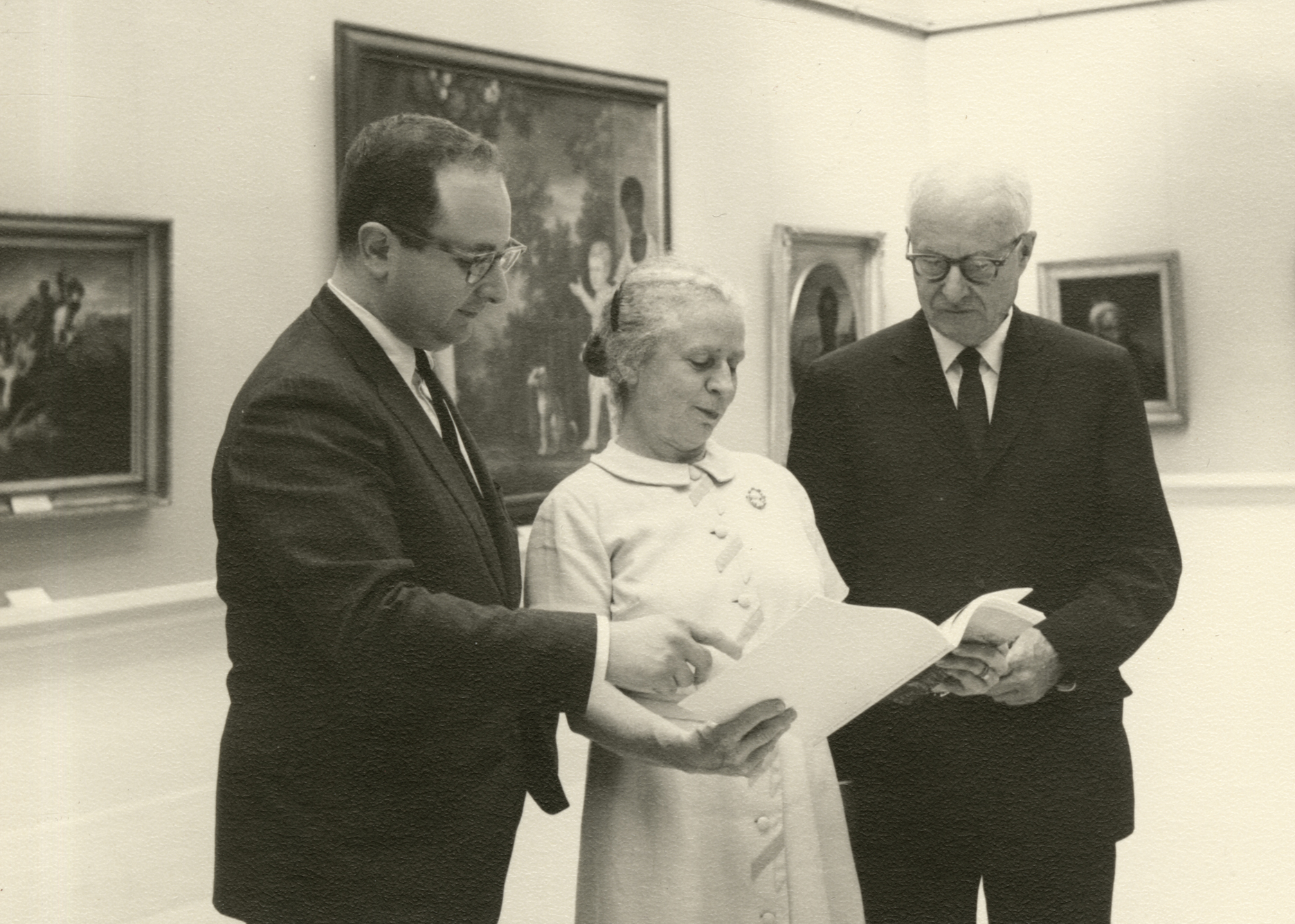
Curator Marvin Sadik with Alfred Baker Lewis (Treasurer of NAACP) with his wife, September 2, 1964. Courtesy Museum of Art Records, Bowdoin College Archives.
“A Powerful Impact”: Martin Luther King, Jr.'s Visit
The Portrayal of the Negro in American Painting opened at a time when the United States was deeply divided by issues of racism, segregation, and the growing civil rights movement. Amid the tense national political and social climate, the Bowdoin College Museum of Art was one of the only institutions to display work featuring African Americans as both the subject and artist.
The exhibition received criticism in local and national press for its seemingly optimistic portrayal of African Americans as “fun loving,” “regarded with affection,” and “a family man who did not question his depressed position.” [1] Aside from its elision of caricatured representations of the Negro, the show was praised for its path-breaking effort to represent African Americans as both artists and subjects in a museum setting. Curator Marvin Sadik’s inclusion of more explicitly politically-oriented paintings, such as Jack Levine’s Birmingham ‘63, made it clear to viewers that the show aimed to incite discourse regarding present-day issues of racial inequality in the United States.
Martin Luther King Jr. was invited to speak at Bowdoin College on May 5, 1964. At the First Parish Church in Brunswick, ME, King delivered an honest and graphic depiction of the discrimination and struggles African Americans experienced throughout history. He repeatedly stated, “We have come a long way, but we have a long way to go,” with respect to issues of civil rights. During his visit King also previewed the exhibition The Portrayal of the Negro in American Painting, about which he commented: “This magnificent collection will have a powerful impact on anyone who sees it, and will be an invaluable aid to understanding between our races.” King’s presence on campus and his related comments about the exhibition thus connected the artistic narrative of the 1964 show to the civil rights movement, while he advocated for greater inclusion and activism at Bowdoin College.
ENDNOTES
[1] John Canady, “Negroes in Art: An Exhibition Examines 250 Years of Pictorial Social History,” The New York Times, May 24, 1964.
CLICK IMAGE TO ENLARGE
Archiving an Historical Achievement
The George J. Mitchell Department of Special Collections & Archives at Bowdoin College houses the exhibition files for The Portrayal of the Negro in American Painting. Numerous photographs, correspondence, and exhibition reviews housed there are a crucial resource for understanding the planning and reception of the monumental 1964 show. In this regard Special Collections enhances our understanding of the exhibition’s historical context. The archives are also a significant tool for learning about the Museum’s curator and director Marvin S. Sadik’s process of realizing this groundbreaking exhibition.
Archive records offer a behind-the-scenes view into Sadik’s ambitious undertaking to present a narrative of African American art of the past 250 years. Sadik reached out to dozens of museums across the United States to determine where relevant works resided. The paintings chosen for the show suggest changing relationships between black and white communities through the eyes of nineteenth and twentieth century artists. Sadik’s exhibition illuminated African Americans as unique contributors as both subjects and artists over the course of American art history.
Sadik envisioned an esteemed audience to visit The Portrayal of the Negro in American Painting. The archives hold the personal invitations he wrote to many powerful figures such as state senators, museum directors, and even-then President John F. Kennedy and the First Lady. Such efforts gained the attention of a local and national audience. Photographs in the archives capture the notable crowd attending the preview of the exhibition as well as its opening, including leaders of the NAACP and the Reverend Martin Luther King Jr.
The archives also hold many reviews of the exhibition from newspapers across the country. While there were earlier precedents (notably The Negro in the American Scene at The Howard University Gallery of Art in 1942), The Portrayal of the Negro in American Painting was often heralded as the first of its kind. The extensive publicity indicates how the exhibition was interpreted in the context of the contemporary cultural landscape. Several newspapers cited the racial tensions evident in the paintings. The exhibition provoked local and national dialogue amid the civil rights movement, and added to the growing interest in African American history.
CLICK IMAGE TO ENLARGE
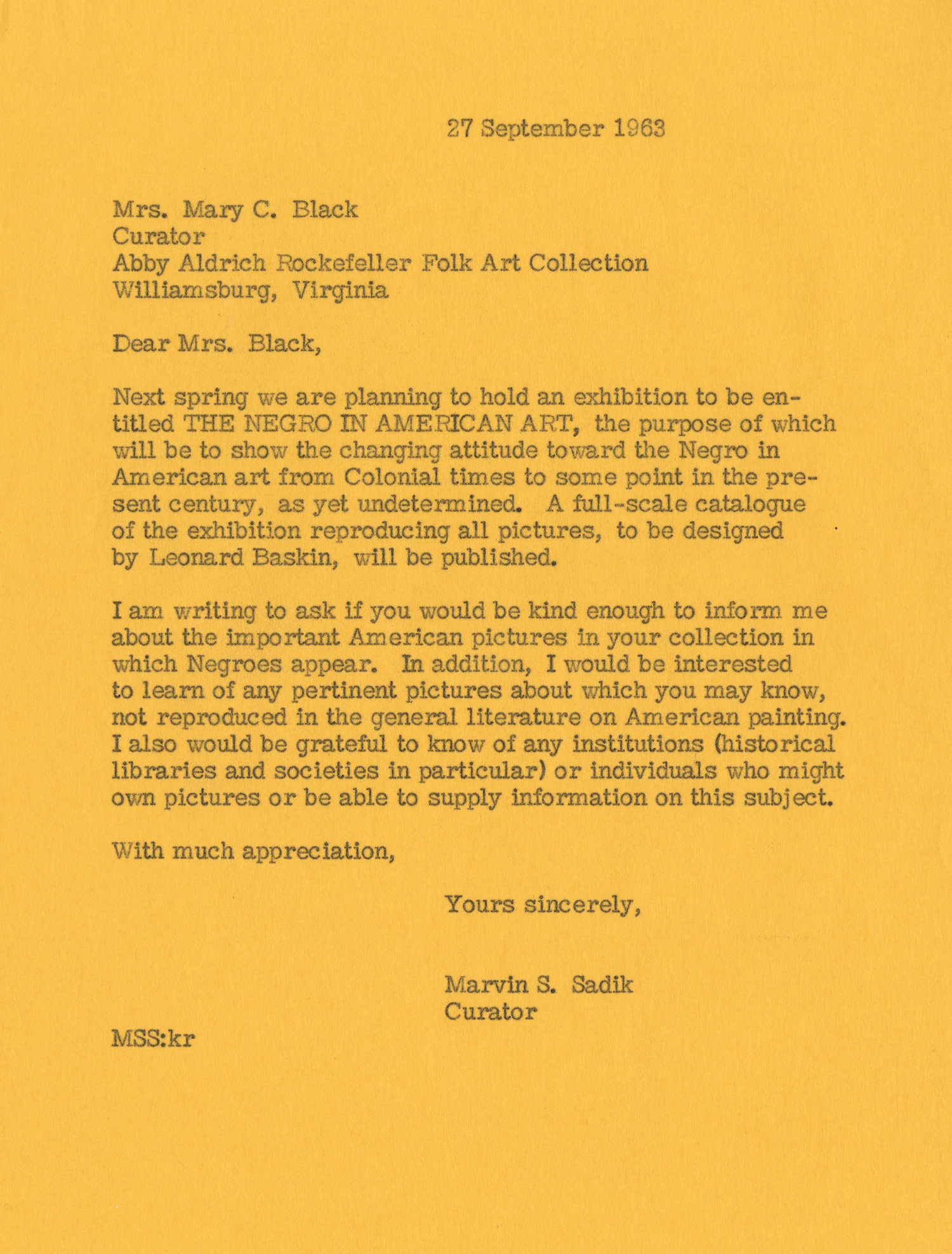
Letter by Marvin Sadik sent to curator of Abby Aldrich Folk Art Collection
Courtesy Museum of Art Records, Bowdoin College Archives
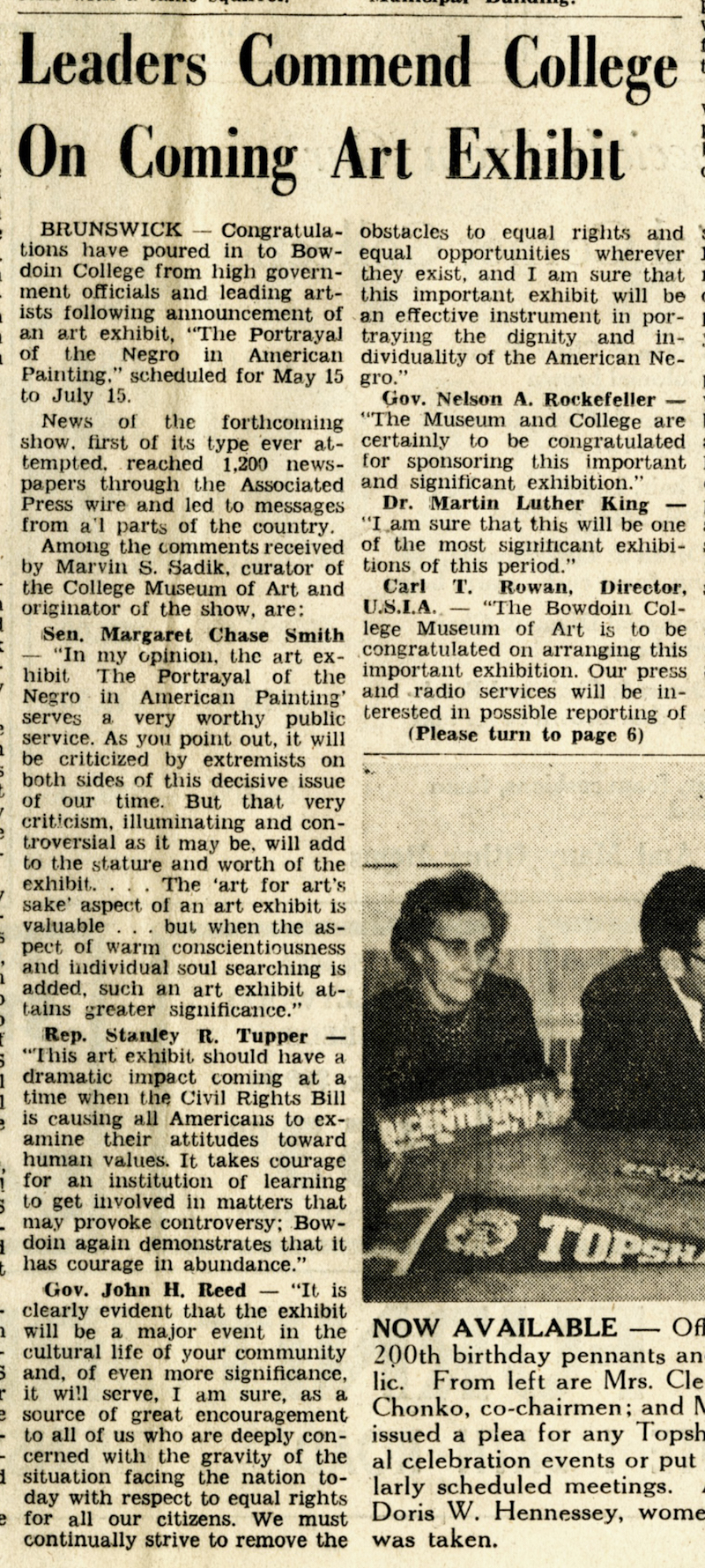
Local newspaper review with comments from numerous government and civic leaders about The Portrayal of the Negro in American Painting
Courtesy Museum of Art Records, Bowdoin College Archives
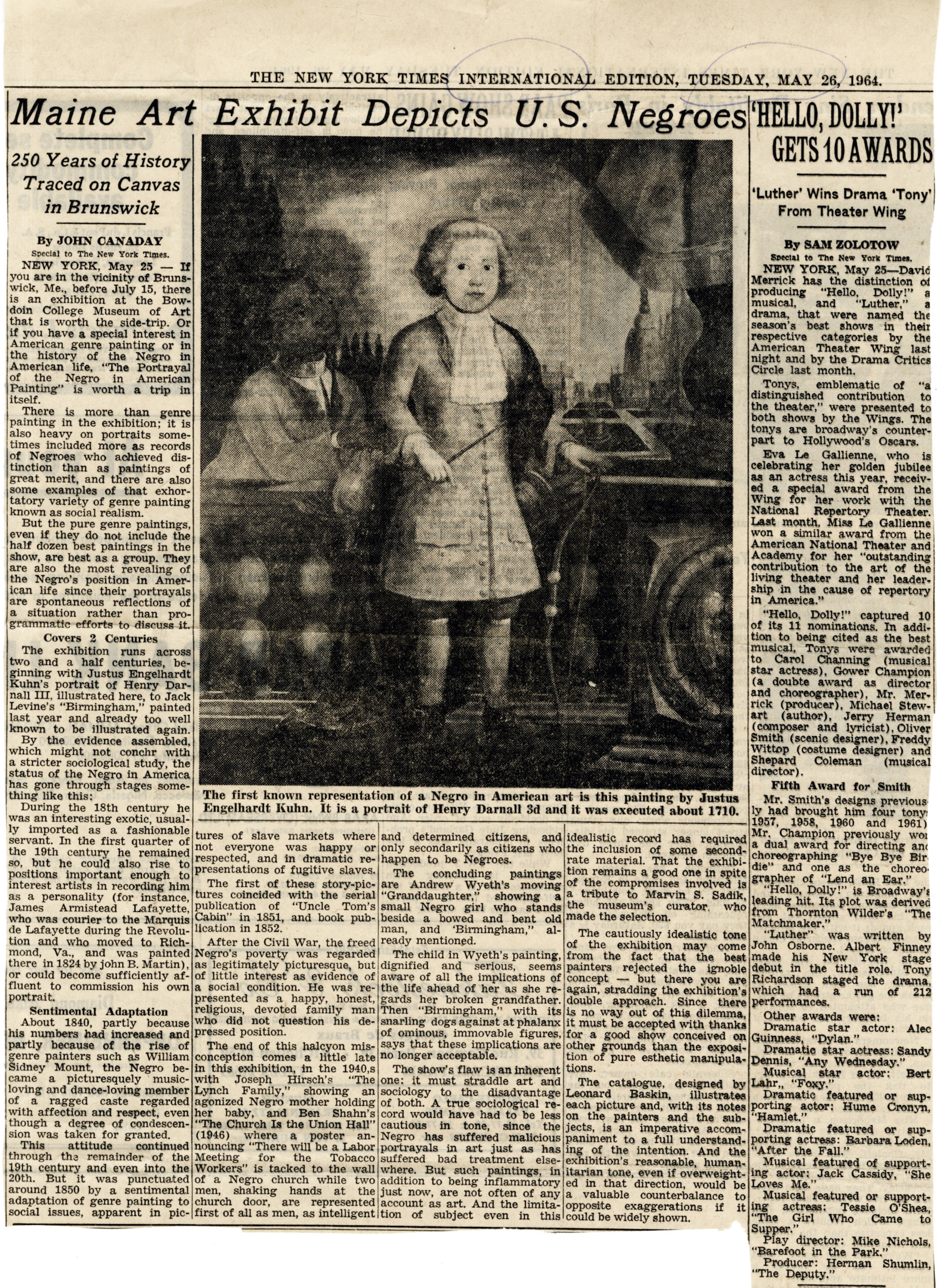
John Canady, “Maine Art Exhibit Depicts U.S Negroes,” The New York Times International Edition, May 26, 1964.
Courtesy Museum of Art Records, Bowdoin College Archives
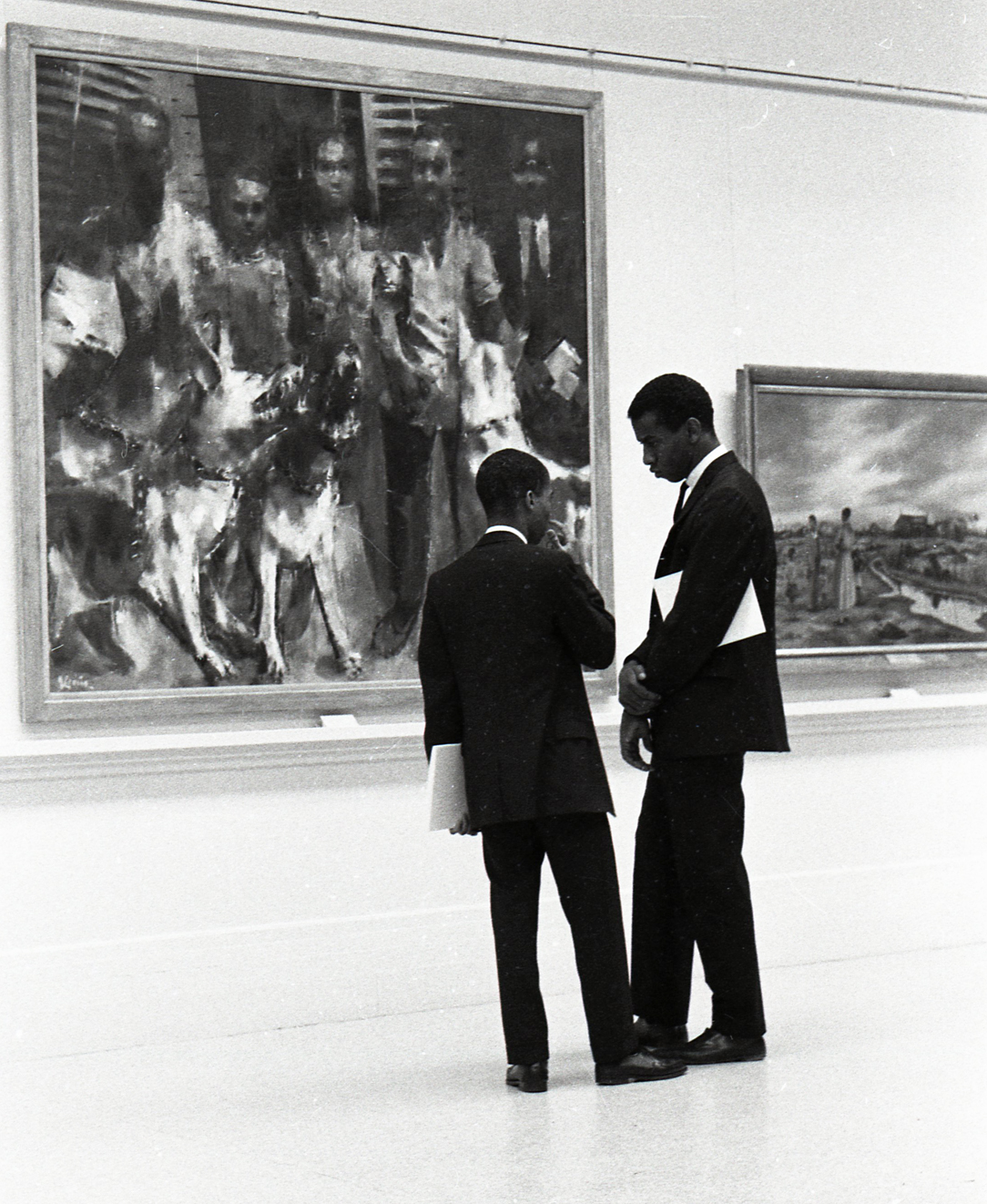
Students standing before Jack Levine's Birmingham '63, 1963
Courtesy Museum of Art Records, Bowdoin College Archives

